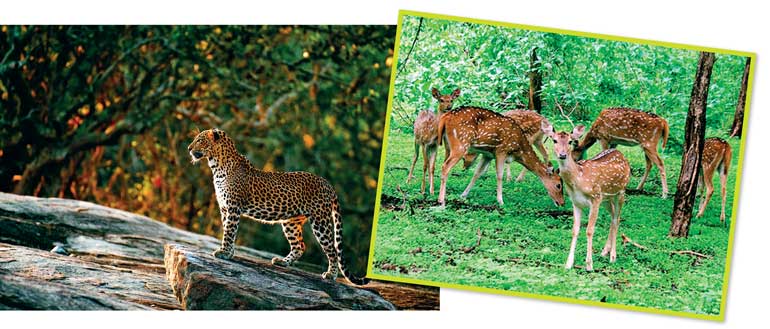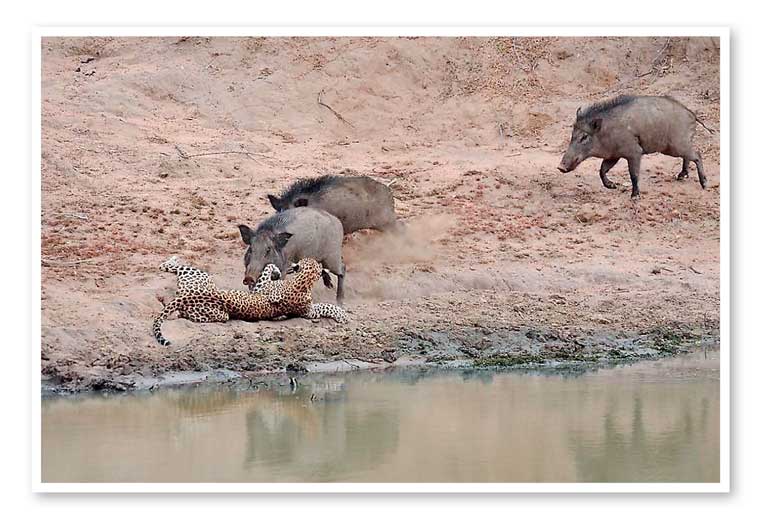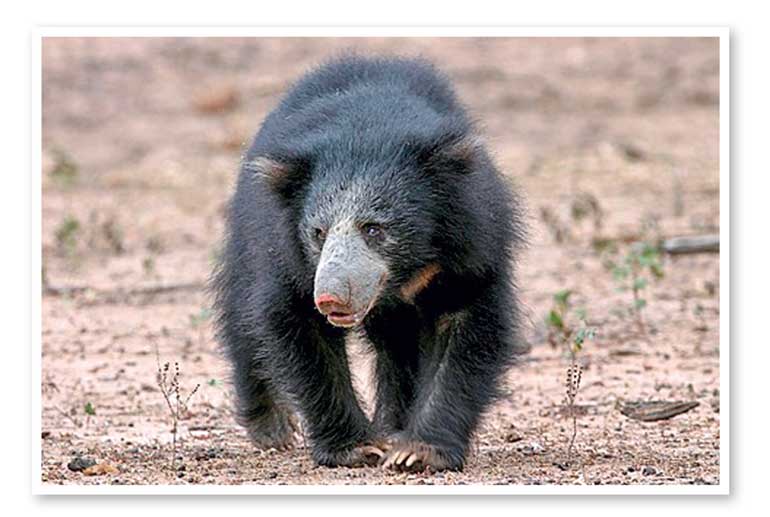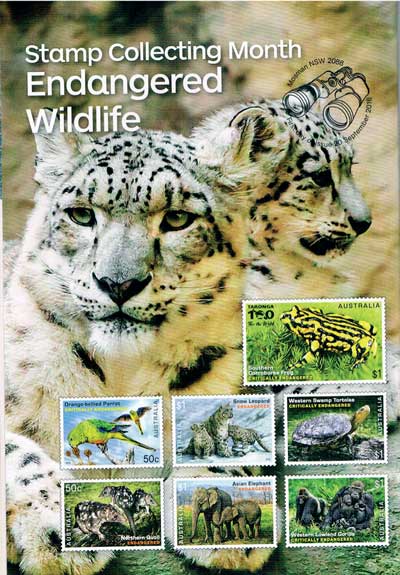Wednesday Dec 31, 2025
Wednesday Dec 31, 2025
Saturday, 8 October 2016 00:05 - - {{hitsCtrl.values.hits}}
By D.C. Ranatunga

Leopard
The leopard (‘diviya’ in Sinhala) is a much-sought-after animal in the national parks. Visitors spend hours and sometimes days to get the glimpse of this member of the cat family. It has been recorded that in the 1870s leopards were found in all forests in Sri Lanka. There have been instances when a leopard suddenly appeared in a coffee plantation and scared the labourers.
The description of a leopard in John Still’s ‘Jungle Tide’ is fascinating. The writer had seen the animal walking down slowly and deliberately up the bed of a stream. He writes: “He was so dignified and calm that I almost blushed for my shameful relatives as he scorned their plebian clamour with aristocratic contempt. If I did not blush then, I have since, for my disgraceful intention to murder an animal so noble.
“Bright and clan, and exceedingly beautiful he looked, and as he came neat I could see the easy power of the muscles moving under his sleek skin as their noiseless pistons bore him onward poised in perfect grace…In saw his intent glare directed upon a spot next to me, and I froze even to the extent of holding my eyelids from blinking. Then his searchlight beam of scrutiny moved one unit, and his eyes looked into mine. I could see how intelligent he was and how utterly untameable; and then in one sudden movement his spring was released, low to earth, black and yellow and bright in the evening sunlight he fled into the forest.”
It has a tawny or rusty yellow coat with dark spots and close-set rosettes. A male weighs around 56kg with a body length of 1.27m, and a 97 cm long tail and a female would be weight 39 kg, body length 1.05 m and tail 84cm.
The diet of the leopard includes small mammals, birds and reptiles as well as larger animals. Spotted deer fall an easy prey for them. It even tackles fully grown buffalos.
With the high demand for leopard skins, poachers are busy at work looking for leopards found mainly in game sanctuaries and protected areas.

Sloth bear
The sloth bear (‘valaha’), an insect-eating mammal has long, shaggy coats that form a mane around the face, long, sickle-shaped claws, and a specially adapted lower lip and palate used for sucking insects. They feed on termites, honeybee colonies, and fruits. Sloth bear sometimes attack humans who encroach on their territories.
An animal that can be tamed, the sloth bear is brought up as pets by some. An ex-police officer in the British times has an interesting story to relate about a pet bear he brought up.
“The golden rule I observed in dealing with him was to show that I was master and would stand no nonsense; for if I was weak he would have turned into a spoilt child and dangerous into the bargain. But I only thrashed him once, which punishment he met by tucking his head into his chest, curling his lips into an angry snarl, advancing on me crab fashion and chewing my club to bits. This was not the time for nervousness I felt. I had to stand my ground and order him to his cage in a thunderous voice. Whining all the time, he obeyed. He was afterwards under perfect control.”
Hennessy dubbed the bear the ‘Clown of the Forest’ but observed that when surprised or angry is so furious that he is more feared by jungle men than any other wild animal except perhaps the rogue elephant.
“He charges on all fours, frothing at the mouth, making a sound between a bark and a roar; and then, when close to his victim, rises up on his hind legs and slashes at the face with his ugly claws, whining and crying as if he were the sufferer. Though his attack is so short, it is terrible; for one blow from his paw is sufficient to pull most of a man’s face away. Should one have the presence of mind to offer a charging bear a stick or some other object, one can generally save oneself, for the animal will vent his wrath on the offered object and make off.” (Extracted from ‘Sri Lanka today Ceylon yesterday’ – H.A.J. Hulugalle)

Deer
There are a few different species of deer that can be seen at the national parks.
Spotted deer (‘thith muwa’) is very common in the dry and semi-arid forests. They are seen in batches of anything from six to a hundred or even more comprising both male and female, young and mature, most of the time grazing on grasses and herbs. They also feed on leaves, fruits and flowers. Being aware of the danger from leopard and crocodile, the spotted deer is always vigilant and has developed a keen sense of smell.
Barking deer (‘olu muwa’), also known as ‘ Mastreani deer’, are small and are believed to be the oldest known deer, which had begun appearing 15 to 35 million years ago. Males have short antlers, which can regrow, but they tend to fight for territory with their “tusks” (downward-pointing canine teeth).
Sambhur deer or elk (‘gona’ – not to be confused with ‘bull’) is the largest deer in Sri Lanka and are seen in batches at the Horton Plains National Park. Considered a noble beast, the male stag carries antlers which are three-tiered.

Other animals
Water buffalo (‘mee haraka’) is bigger and darker in colour than the normal village type. The ash coloured body when it is dry, turns to blackish brown when wet. The male which is around five feet in height is larger than the female. It carries longer and heavier horns. Generally seen in groups where a mature male is the group leader. It is dependent on water and spends most of its time wallowing in mud holes and shallow pools. They are seen mainly where there are rivers, lagoons and abandoned tanks. Eats manly grass and feeds in the morning and evening.
Wild boar (‘val ura’), a member of the hoofed family, is seen in groups of four or five. It digs the soft earth with the nose for yams and worms and leaves a mess with soil upturned. The male has a fairly long and large pair of tushes while the female’s tushes are smaller. They love to lie in mud. Protective of the little ones, the wild boar attacks even stronger animals if they try to harass the babies.
A variety of monkeys (‘vanduro’) can be seen frequently, the smallest being a macaque (‘rilawa’), brown animal with a full tuft of hair on the face. It is gregarious and lives on wild fruits, berries, young shoots and flowers and insects. The monkeys generally look for food in gangs, sometimes going up to 20.
Among other animals are the jackal (‘nariya’) – dog-like in appearance, reddish brown in colour, generally treated as the scavenger of the jungles; the wild pig (‘wal ura’) – seen in swampy areas around ranks and lagoons, living on roots, tubers, fallen fruits, grub and carrion; the mongoose (‘mugatiya’) – feeding on small mammals, lizards, insects and eggs; porcupine (‘ittava’) – with the back clad in black and white quills, nocturnal in habit; hare (‘haava’) – light greying brown in colour and nocturnal; crocodile (‘kimbula’) – the largest and the most dangerous of the lizard family, growing up to 20 feet in length; water lizard (‘kabaragoya’) and monitor lizard (‘talagoya’) – both harmless creatures.
Sri Lanka also boasts of a wide variety of birds.
 Just as much as conservation of fauna is a hot topic, so is the problem of endangered animals.
Just as much as conservation of fauna is a hot topic, so is the problem of endangered animals.
‘Endangered Wildlife’ was the theme of a set of seven stamps released recently to coincide with the Stamp Collecting Month – September. The animals selected for the stamps are at risk of extinction and are classified as either Endangered or Critically Endangered according to both Australian and international standards.
Leading the set of stamps is a definitive stamp, larger than the rest, featuring the Southern Corroboree Frog (Pseudophryne corroboree) – one of the world’s rarest frogs. The small, brightly coloured amphibian is just 2.5-3cm in length. It got its name because its striped look was thought to resemble the ceremonial markings indigenous Australians put on their bodies in preparation for a corroboree. It falls into the Critically Endangered category.
One of the world’s rarest and most endangered species is the Orange-bellied Parrot (Neopheme chrysogaster) which is on the brink of extinction. Around 21 centimetres in length, this migratory bird is endemic to southern Australia and breeds only in coastal south-west Tasmania spending its winters in coastal Victoria and South Australia.
The carnivorous Snow Leopard (Panthera uncia syn) is a large cat native to mountain ranges of central and south Asia at altitudes of 3,000 to 4,500 metres. They are rarely seen because they inhabit harsh terrain with an extreme climate and are distributed across a range of over two million square kilometres across 12 countries. It has been estimated that currently there are just 4,000 to 6,500 snow leopards.
The short-necked freshwater Western Swamp Tortoise (Pseudemydura umbrina) is a rare species found only in two locations in a small area of the Swan Coastal Plain in Western Australia. Measuring just 11 to 13cm from nose to tail, it is Australia’s most endangered reptile.
The Northern Quill (Dasyurus hallucatus) is the smallest of four Australian species of quoll weighing up to 1.2 kilograms. It has a pointy stout and reddish brown fur with a cream underside. It has white spots on its back and rump and a long, unspotted tail.
The Asian Elephant (Elephas maximus) – an animal that used to roam over most of Asia is now restricted to just 15% of its original range. A rapid decline up to at least 50% has been noticed over the past 60-75 years reducing to the numbers to around 41,430. Asia’s largest terrestrial mammal reaches up to 6.4 metres in length and 3 metres at the shoulder.
Another in the Critically Endangered category is the Western Lowland Gorilla (Gorilla gorilla gorilla) – a large primate native to the rainforest of South Africa. Gorillas are mainly herbivorous and their staple foods are pith, shoots and leaves. They also eat fruits. The total population is thought to be around 1000,000 though it has not been able to arrive at a firm figure since they inhabit some of Africa’s densest and most remote rainforests.